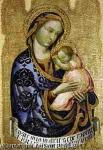Jacobello Del Fiore
Jacobello Del Fiore
Place: Venezia
Born: 1370
Death: 1439
Biography:
Jacobello del Fiore was a Venetian artist in the late fourteenth century and early fifteenth century. His early work is in the Late Gothic style popularized by Altichiero da Verona and Jacopo Avanzi, two of his contemporaries, while his mature work displays a local Venetian style established by the school of Paolo Veneziano, an artist and workshop proprietor with notable Byzantine inspiration in his work. This stylistic return to his roots sets him apart from Niccolò di Pietro and Zanino di Pietro, Venetian contemporaries he is often associated with. During his lifetime, he received commissions primarily on the Adriatic coast and in Venice.
Jacobello del Fiore is likely to have been born around 1375, since by the time of his marriage in 1394, he was still under the tutelage of his father, Francesco del Fiore. While it is known that Jacobello del Fiore was married in 1394, the identity of his spouse is unknown, as is whether or not he had children. Jacobello's father, Francesco, was a painter himself: in 1376 he is documented in a contract as the chief officer of the confraternity, or organization dedicated to recognizing Christian works of charity, Scuola dei Pittori. Francesco headed a workshop that included Jacobello and his two brothers, Nicola (who died in 1404, when Jacobello was in his twenties or thirties) and Pietro.
While Jacobello's earliest surviving and confirmed work is dated in 1407, he is thought to be the painter of a Crucifixion piece in the Matthiesen Collection and the Virgin and Child of Piazzo Giovaneli, both painted in the late 14th century. The Crucifix was a common theme in Jacobello's earliest works, though as a subject it was a fairly common focus of many painters at the time. Art historian Andrea de Marchi was the first to suggest that a single author was responsible for these 'neo-giottoesque' paintings inspired by mainland painters Altichiero and Jacopo Avanzi and coined the author's unknown name as "Master of the Giovaneli Madonna". In the Matthiesen Crucifixion, Christ hangs on his cross in the center of the scene, dividing the followers of Christ on the left with the soldiers on the right. These details reveal that the author of the painting must have been familiar with the Late Gothic movement of the mainland and had Venetian training as well, due to the depiction of Longinus who lances Christ and the centurion who orders Christ's legs to be broken, two figures that also appear in Altichiero's Crucifixion in the Oratorio di San Giorgio, and also the city wall that closes the scene, a technique used by Paolo Veneziano. Similarly, art historian Carlo Volpe noted that a series of small Passion panels painted in the 1390s––Agony in the Garden (Vatican Picture Gallery), Lamentation (Vatican Picture Gallery), Way to Calvary (British Royal Collection), and Arrest of Christ (private collection)––share a Paduan influence and stylistic similarity with that of the Matthiesen Crucifixion." De Marchi also attributes The Madonna of Humility in a provincial museum in Lecce to the "Master of the Giovaneli Madonna", thus connecting this work with the Matthiesen Crucifixion and the Passion panels as well.
In 1401, Jacobello sent a polyptych, which has since been lost, to the church of San Cassiano in Pesaro, where it was seen by the 18th-century art historian Luigi Lanzi. The Madonna of Humility in Lecce, according to art historian Illeana Chiappini di Sorio, may well have belonged to this polyptych. Thus, the Madonna of Humility, as hypothesized by art historian Daniele Benati, connects all of the above works by the "Master of the Giovaneli Madonna" to none other than Jacobello del Fiore.
The year 1401 marks a transition in Jacobello's career from a more archaic, gothic style, utilized in the last decade of the Trecento and captured in the Matthiesen Crucifixion, to a more modern style concerned with line, as seen in the Giovaneli Madonna and Crucifixion with Mourners and Saints in a French private collection. The latter, as De Marchi emphasizes, still derives from Altichiero and Jacopo Avanzi but moves beyond the sterner style of the Matthiesen Crucifixion by employing a looser Gothic flexibility. Both these works were probably painted between 1401 and 1407, the date of Jacobello's first surviving, verified painting.
The Matthiesen Crucifixion contains allusions to Jerusalem and to biblical imagery such as the Golgotha, the location where Jesus was crucified. The older gothic style that Jacobello often used, exemplified by the Matthiesen Crucifixion, is characterized by distinct composition and posing of figures in front or side view, sweeping lines, and vivid colors, though the scheme of the Matthiesen Crucifixion is especially bright.
In 1407 Jacobello painted a triptych of the Virgin of Mercy with Saints James and Anthony Abbot now residing in the church of Santa Maria delle Grazie in Pesaro but originally for the church of Santa Maria in Montegranaro. This triptych, according to Benati, reveals Jacobello's interest in the latest artistic trends: its technique and style are up to date, and the pinched nose of the Virgin points toward the influence of Lombard's Michelino da Besozzo. Similar influences found in Jacobello's triptych of the Adoration of the Magi in Stockholm, Nationalmuseum, place it chronologically near the Virgin of Mercy triptych.
More...
Wikipedia link: Click Here













